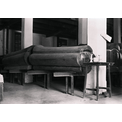
- Chinese coffin in Tung Wah Coffin Home
Coffins and urns of bones were kept in the coffin home established by Tung Wah Hospital before they were repatriated to the deceased's hometown. This photograph, taken in circa 1950s, shows a Chinese coffin in the home pending burial.
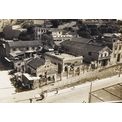
- Yat Pit Pavilion in Kennedy Town
The Tung Wah Hospital operated communal graveyards and cemeteries so that unclaimed remains or victims of major disasters could be buried. In the early 20th century, Tung Wah established "farewell pavilions", such as the Yat Pit Pavilion in Kennedy Town, the Wing Pit Pavilion in Pokfulam, the Chien Lee Pavilion in Ho Man Tin and the Sik Pit Pavilion in So Kon Po, to provide a venue for the public to bid a last farewell to their deceased loved ones. This is a photograph of the Yat Pit Pavilion in Kennedy Town.
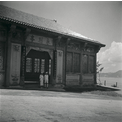
- Wing Pit Pavilion in Pokfulam Chinese Cemetery
Built by TWGHs in the Pokfulam Chinese Cemetery, the Wing Pit Pavilion was a place for conducting funeral rites and memorial services for the deceased. This photograph was taken in the 1930s. The pavilion has since been demolished. (TWGHs, Tung Wah Group of Hospitals)
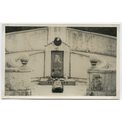
- Headstone in Slaughter House Cemetery, Sai Wan
Established in 1869 in Sai Wan, the Slaughter House Cemetery was Tung Wah's first communal cemetery. Initially it was set up to bury skeletal remains discovered during the construction of the Tung Wah Hospital, but later unclaimed remains were also buried there.
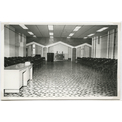
- Hall in International Funeral Parlour
The opening ceremony of the TWGHs International Funeral Parlour was held on 13 February 1980. This photograph shows a hall in the funeral parlour. (TWGHs, Tung Wah Group of Hospitals)
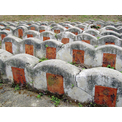
- Jinniu Shan Overseas Chinese Cemetery
About 1,500 tombs at Jinniu Shan Overseas Chinese Cemetery, located in Hezui in Huangchongkeng, Xinhui, Guangdong province. The tombs are believed to have been built during the tumultuous 1940s. While any main and memorial tombstones have not been found, the tomb of "god of the earth" was inscribed with the words "erected by Ren'an Hospital". Ren'an Hospital is a benevolent society-type fangbian yiyuan (shelter and clinic), where coffins are reposed. According to the archives of the Tung Wah Coffin Home, Ren'an was one of the collection points for coffins and urns of bones returning to Xinhui from overseas.
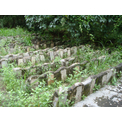
- Xinhui Huangkeng Haihuai Overseas Chinese Cemetery (1)
Tombs in the Xinhui Huangkeng Haihuai Overseas Chinese Cemetery in Guangdong province. Most of the headstones and carves have already been damaged. The carved words on them are vaguely visible.
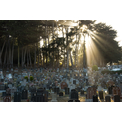
- Yuqingtang Cemetery in San Francisco, United States
Unlike other benevolent associations, the Ning Yung Company operates its own graveyard named the Yuqingtang Cemetery in San Francisco, the United States. This is so that deceased fellow countrymen can find eternal peace.
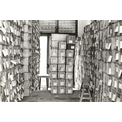
- Boxes of bones in Tung Wah Coffin Home
Boxes of bones stored in the Tung Wah Coffin Home around 1960.
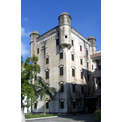
- Historic site of Kaiping Baihe Xu Committee
The Kaiping Baihe Xu Committee was situated in a diaolou structure (fortified multi-storey tower). In the olden days, repatriated skeletal remains of Chinese from Kaiping and Enping (and sometimes Taishan) were placed here until they were claimed. The historic site is located in the present-day Kaiping Baihe Middle School.
